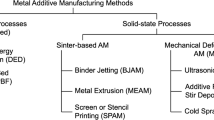Abstract
Fast-moving machine tool assemblies should be light and rigid. Because of the lightweight construction and the dynamic loads these assemblies are very often susceptible to vibrations. Aluminum foam sandwiches are laminates with an aluminum foam core and compact cover sheets. The foam cores possess a high-energy absorption capacity. Machine tool assemblies made of aluminum foam sandwiches offer very high flexural stiffness, together with comparatively light weight. Vibrations generated by machining are damped very well due to the cellular structure of foam. The manufacturing process of foam sandwiches is in general well understood, but there are still some open questions concerning the mechanisms of bonding and adhesion between cover sheets and foam core. This paper tries to give answers to these questions.










Similar content being viewed by others
References
Hipke T, Hohlfeld J, Thümmler R (2003) Metallschaum – Konstruktionswerkstoff für den Werkzeugmaschinenbau. Metall 57(9):557–562
Hohlfeld J, Hipke T (2005) Zellulare Metalle auch in Werkzeugmaschinen. Industrieanzeiger 127(30):29–30
Neugebauer R, Hipke T (2002) Metallschäume bringen Ruhe in die Werkzeugmaschine. Industrieanzeiger 124(5/6):46–47
Hipke T (2002) Analyse, Bewertung und Eignung von Aluminiumschäumen für die Werkzeugmaschinenkonstruktion. Dissertation, TU Chemnitz, Verlag wissenschaftliche Scripten, Zwickau
Neugebauer R, Hipke T, Thümmler R, Hohlfeld J (2005) Metal-foam—high potential material for machine tool building. In: Stephani G, Kieback B (eds) Cellular metals for structural and functional applications. International symposium CellMet, May 18th–20th, 2005, Dresden, Germany, pp 85–90
Thümmler R, Hipke T, Schneider F, Fahrni S, Fraaß M (2006) Gefüllte Hohlräume. Maschinenmarkt Nr. 36:108–111
Neugebauer R, Hipke T, Hohlfeld J, Thümmler R (2004) Ein Weg zu leichten Bauteilen. Der Konstrukteur 34(Nr.12):16–18
Riehle M, Simmchen E (2000) Grundlagen der Werkstofftechnik. Deutscher Verlag für Grundstoffindustrie (DVG), Stuttgart
Awiszus B, Bast J, Dürr H, Matthes K.-J (2005) Grundlagen der Fertigungstechnik, 2 edn. Fachbuchverlag Leipzig
DIN Deutsches Institut für Normung e. V. (ed) (1982) DIN 53295, Prüfung von Kernverbunden – Trommel-Schälversuch
Eggeler G, Auer W, Kaesche H (1987) Zum Angriff von Aluminiumschmelze auf niedriglegierten Stahl. Mater Corros 38(Nr. 7):351–355
Forschungsbericht P 281.1, Industrielle Nutzung von Stahlblechverbundwerkstoffen mit geschäumtem Aluminium, Projekt 1: Sandwichkonstruktionen aus Stahlblech mit geschäumtem Aluminium. Studiengesellschaft Stahlanwendung e. V., 1997
Massalski TB (1990) Binary alloy phase diagrams. ASM International, New York
Author information
Authors and Affiliations
Corresponding author
Rights and permissions
About this article
Cite this article
Neugebauer, R., Lies, C., Hohlfeld, J. et al. Adhesion in sandwiches with aluminum foam core. Prod. Eng. Res. Devel. 1, 271–278 (2007). https://doi.org/10.1007/s11740-007-0046-4
Received:
Accepted:
Published:
Issue Date:
DOI: https://doi.org/10.1007/s11740-007-0046-4




